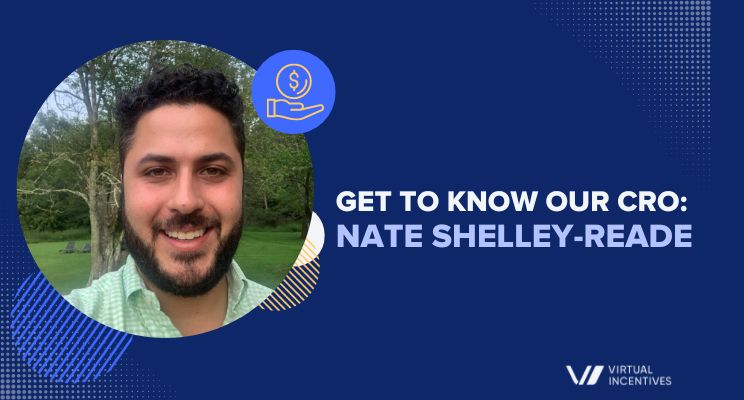Congratulations to Nate Shelley-Reade on his recent and well-deserved promotion to Virtual Incentives’ Chief Revenue Officer! Nate has been with us since 2021, first as our Senior Vice President of Growth and Partnerships, and has led the rapid expansion of our global customer base and partnership network.
We sat down with Nate to discuss his experience, how he’s working to optimize the payout process, and what the future holds for Virtual Incentives and the industry.
Tell us about your professional background and what led you to join Virtual Incentives.
I began my career at Axiom, a startup focused on disrupting the legal services industry through creating new business models for Fortune 500 companies. I worked with investment banks, pharma companies, and tech and media companies, focusing on building a next wave of managed services in legal. As the company matured, I transitioned into a solution architect / sales role, selling and structuring large managed service deals in the US and Europe.
I left Axiom to join a wonderful team within EY where I was able to apply that skill set and way of thinking to help sell, structure, price, and contract large deals in various sectors including banking, insurance, wealth and asset management, and pharma. I was part of the initial 4-6 person multi-disciplinary team that is now over 70 members, playing a central role in EY’s largest deals.
I joined Virtual Incentives in 2021. The company’s big vision and mission, and the culture and team here, excited me. Today, I’m proud to have helped grow our presence across several industries, but feel that we have an immense opportunity to continue that growth and deliver more value for clients.
There are various stakeholders to consider whenever a company issues rewards and incentive payments. How do you approach helping VI’s clients overcome that inherent complexity and optimize the entire payout process?
I would say there are three key components of the approach here: alignment (of outcomes), measurement, and innovation.
First, we must align with our clients on their desired business outcomes. Too often in these spaces, partners have different, or even conflicting, objectives. Instead of having a zero-sum relationship, we focus on creating a win-win situation where we all benefit from improved outcomes for our clients’ stakeholders. This alignment ensures that all parties involved are motivated to work towards the same outcomes, and a differentiated experience.
Second, we believe the old adage “you get what you measure.” Historically, many costs and benefits in our industry have been hidden or have been hard to measure. We want to change that by focusing on the ultimate ROI and program health, ensuring our goals align to achieving our clients’ stated goals. For example, our client’s end goal in employee engagement may be create a more connected workforce, and reduce dissatisfaction that leads to attrition–we need to focus on how we can help deliver that. The challenge lies in measuring our impact and holding ourselves accountable for results – though when we do, it creates the best results for our clients.
Finally, we continually explore innovative approaches, products, processes, and ideas from other industries or sectors. Often, we get to act as a bridge between our fintech industry and the industries that our clients operate in, allowing us to introduce novel solutions to our clients from outside their space, yielding differentiated outcomes through creative approaches.
By incorporating all three of those–aligning goals, measuring our impact, and constantly innovating–we can help tackle complex business problems, and drive continuous improvement.
Where do you see Virtual Incentives going, and what role will you play in shaping its future?
Our goal is to build tailored solutions that help organizations achieve better outcomes and fully solve some of their payouts challenges in the use cases that we focus on, including, consumer acquisition, insights and research, employee appreciation, device trade-ins, and clinical trial payouts.
In the next 18 to 24 months, I would love to see us deepen our multifaceted relationships with clients, and help solve various challenges that, while they might manifest in payments, have large impacts for our clients. This could include improving the quality of market research respondents or innovating the recipient experience for employees to make it that much more special.
As for my role at Virtual Incentives, I get the really fun job of being a conduit between our clients and our innovation agenda – bringing the latest of what we have to offer to our clients and helping our team target the next set of opportunities to deliver client value.
You graduated from Brown University (Go Bears!). How has your education informed your approach to problem-solving?
Yes–I had a great time there. There was always a focus on multi-disciplinary study, so while I majored in sociology, I was able to find my way to a wide range of subjects–including some wonderful entrepreneurship courses with Professors Warshay, Mittleman and Hazeltine.
All of those classes encouraged us to think about building businesses over products and not shy away from the big, hard, complex challenges.
